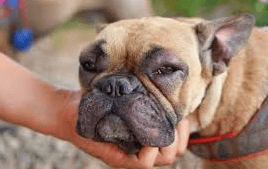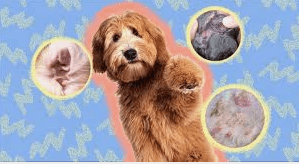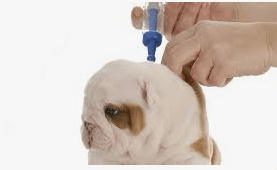Tear stains can be healed naturally. Tear stains are a common cosmetic issue that is characterized by reddish-brown staining under the eyes. Typically, it is caused by porphyrins, which are pigments in tears that stain fur.
The causes of tear staining include excessive tearing (epiphora, which can lead to more staining include genetic and environmental factors. For instance, certain breeds such as Schnauzers, Cocker Spaniels, Dachshunds, Pekingese, Poodles, Calm and West Highland Terriers are particularly genetically predisposed to tear staining.
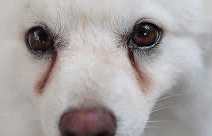
Other environmental factors like diet, which include food sensitivities, food allergies, low-quality food and excessive iron intake can contribute to tear staining. Additionally, eye and ear infections can increase tear production and block tear ducts. Lastly, allergens to pollen, dust, mold, harsh chemicals in cleaning products and vaccine reactions can also cause and exacerbate tear staining. The good news is, tear stains can be healed naturally.
In order to truly heal tear stains, it is helpful to identify what caused them in the first place. Is it diet? Is it some kind of allergen? Could it be vaccines? If it could be one of these things or a combo of these things, the protocol is still the same.
First, make sure you are feeding your dog a high quality diet. Feeding raw or home-cooked is best because you can ensure there are no allergy inducing ingredients. Some dogs are particularly sensitive to protein source. Other dogs are sensitive to wheat and grains, dairy, eggs and corn. You can spend lots of money on allergy testing, or you can heal tear stains naturally with a detox/elimination diet.
Bobzilla recommends home-cooking a whitefish and veggie recipe, which is especially helpful for dogs that have yeast, staph or tear stains. An allergy to whitefish is very rare and this diet has been well-tolerated by thousands of dogs that have tried this protocol. In a large pot, you simply cook the whitefish such as tilapia or cod fish with green vegetables such as kale, zucchini, broccoli, green beans, lettuces, bok choy, alfafa sprouts, dandelion greens, spinach or celery. We recommend using a combination of at least 3 veggies. Do not use peas as they could be an allergen. We like to do an 80% protein and 20% vegetable ratio. In other words, if you were making 10lbs of food, 8lbs should be meat and 2lbs should be veggies. You can read more on this dietary protocol here.
When I got my first English Bulldog, Sheldon, I fed him Royal Canin's Bulldog formula because that is what my vet recommended. He had horrible tear staining that I tried my best to clean daily, but nothing I did really helped until I switched his diet. I switched him to the whitefish diet protocol described above and not only did his tear stains disappear, so did his autoimmune disease, which is his former vet said "would never go away". So if you are on the fence about trying the whitefish protocol, I highly recommend it. You've got nothing to lose.
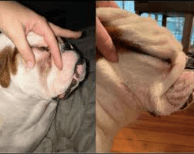
In addition to food, adding a teaspoon of apple cider vinegar to your dog's food or daily drinking water to help rebalance your dog's pH levels, which refers to your dog's individual biochemistry. Certain medications such as omeprazole and Pepcid, medications used to decrease stomach acid production, can increase stomach pH levels and lower pepsin levels (source: NorthPointPets), which could cause a pH imbalance and increase tear staining.
Coupled with diet, there are hygiene and cleaning steps you can take to heal tear stains naturally. First, make sure you clean the tear stains daily with a damp cloth or natural wipe to remove any accumulated tears or debris. Always try to keep the fur trimmed by the eye to prevent if from irritating the eye and trapping moisture.
Second, you can try applying topical solutions:
- Coconut oil has both antibacterial and anti-fungal properties and can be applied to the tear stains to help soften the fur and break down stains.
- Hydrogen Peroxide can be used to lighten tear stains, but you have to dilute it to avoid eye irritation. The ratio of hydrogen peroxide to water should be 1:10. In other words, for each teaspoon of hydrogen peroxide, you should mix it with 10 teaspoons of water. Simply dip a cotton ball in the hydrogen peroxide/water solution and gently wipe the tear stains. Test the solution on a small area first to ensure it doesn't irritate.
- Activated Charcoal / Bentonite Clay Paste: Mix equal parts of activated charcoal and bentonite clay and 2x time the amount of filtered water or apple cider vinegar to make a "paste" like texture. In other words, take 1 tablespoon each of activated charcoal and bentonite clay and mix with 2 tablespoons of filtered water or apple cider vinegar. You can make more or less as needed. I like to make this in bulk to have on hand when needed. Next, apply the paste to the cyst and wait 20 minutes to take it off with a warm compress. Warning: this can be messy so removing in a bathroom or outside is ideal. This paste naturally draws out toxins and detoxifies the tear ducts.
Tear stains can be healed naturally, with a bit of time, patience and persistence. If your dog has them, you've got nothing to lose by changing his or her diet and trying the topical solutions mentioned above. Feeding a high quality diet comprised of protein, veggies and some fruit that most closely resembles what they would eat in the wild is the best way to eliminate allergen exposure, reduce inflammation and detox the body and ultimately, heal tear stains naturally. Please check out our raw food brand recommendations, home-cooked and supplement recommendations to learn more about what to feed your dog. If your dog is sick and you need some guidance on helping them feed better, please visit Bobzilla's Happy, Healthy Life Made Simple.
Donate to Bobzilla.org

$5.00
The veterinary business is business which is not in the business of curing your animal, but Bobzilla's business is. Bobzilla is committed to one hundred percent transparency in all of its scientific research into animal wellness and prevention of disease and one… read more

